Welcome to our free classical music site

Do you write about classical music? Are you a blogger? Want to team up with Classical Connect? Send us a message, let's talk!

Do you write about classical music? Are you a blogger? Want to team up with Classical Connect? Send us a message, let's talk!
February 18, 2013. Boccherini and Handel. For centuries, Italy, and Rome in particular, has attracted the best of composers of the time. Starting with the Renaissance, when Flemish and Spanish musicians practically created Italian music before the Italians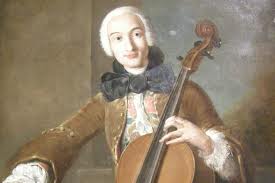 got to it, during the Baroque era, and even in the 19th and 20th centuries (take for example the French Prix de Rome), composers from different countries flocked to Rome and Naples. But of course it was not a one-way street, and some Italian composers went to foreign countries: Jean-Baptiste Lully – to France, Domenico Scarlatti – to Spain. And so did Luigi Boccherini. Boccherini was born in Lucca on February 19, 1743. As a young boy he was sent to study in Rome. When he was fourteen, his father took him to Vienna, where they worked in the band of the imperial Burgtheater. In 1761 Boccherini went to Madrid and stayed in Spain for the rest of his life (he died in 1805). One of the best pieces he wrote was the Cello concerto in B flat Major, the ninth of his cello concertos. Boccherini was a talented cellist himself, and composed 12 concertos for this instrument. You can listen to it here (courtesy of YouTube) in the performance by the 22-year old Jacqueline du Pré, with Daniel Barenboim conducting the English Chamber Orchestra (the recoding was made in April of 1967; Barenboim and du Pré married in June of that year in Jerusalem, right after the end of the Six-Day War).
got to it, during the Baroque era, and even in the 19th and 20th centuries (take for example the French Prix de Rome), composers from different countries flocked to Rome and Naples. But of course it was not a one-way street, and some Italian composers went to foreign countries: Jean-Baptiste Lully – to France, Domenico Scarlatti – to Spain. And so did Luigi Boccherini. Boccherini was born in Lucca on February 19, 1743. As a young boy he was sent to study in Rome. When he was fourteen, his father took him to Vienna, where they worked in the band of the imperial Burgtheater. In 1761 Boccherini went to Madrid and stayed in Spain for the rest of his life (he died in 1805). One of the best pieces he wrote was the Cello concerto in B flat Major, the ninth of his cello concertos. Boccherini was a talented cellist himself, and composed 12 concertos for this instrument. You can listen to it here (courtesy of YouTube) in the performance by the 22-year old Jacqueline du Pré, with Daniel Barenboim conducting the English Chamber Orchestra (the recoding was made in April of 1967; Barenboim and du Pré married in June of that year in Jerusalem, right after the end of the Six-Day War).
George Frideric Handel was born February 23, 1685 in Halle, now Germany and back then – Duchy of Mageburg in Brandenburg-Prussia. He settled in England in 1712, becoming a British subject and, eventually, a national composer, but before that he, like so many, traveled to Italy. The year was 1706, Handel was only 21 but already an author of two operas. He arrived in Florence first, but then moved to Rome, where he stayed for four years. He wrote two more operas, Rodrigo and Aggripina. Both were staged outside of Rome, the former in Florence, the latter in Venice: at the time Pope Clement XI banned all opera performances in favor of sacred music. Handel also wrote cantatas and several oratorios. Here’s an excerpt from one of them, the oratorio La resurrezione, written in 1708. It’s performed by the Amsterdam Baroque Orchestra, Ton Coopman conducting (courtesy of youTube).
PermalinkFebruary 11, 2013. Arcangelo Corelli. The Italian composer and violinist was born on February 17, 1653 in a small town of Fusignano, not far from Ravenna. He studied music in the nearby Faenza, better known for its ceramics than music,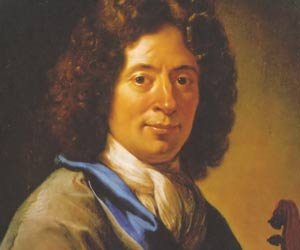 and then moved to Bologna, which indeed was an important cultural center of the time. Bologna had a famous school of violin playing, and Corelli studied with several noted violinists. It is said that around that time he probably made several trips abroad: to France, where he might have met Jean-Baptiste Lully, and to Germany. He later moved to Rome, where he found several influential patrons, Cardianl Ottoboni and Queen Christina of Sweden being the major ones. He had pupils, some of whom became quite famous as composers, for example Francesco Geminiani and Pietro Locatelli, and many violinists. Corelli’s greatest contribution was in the development of Concerti Grossi. In a concerto grosso the musical interplay happens between a small group of soloists and the full (usually string) orchestra. Corelli’s concerti grossi constitute his famous Opus 6, the first eight compositions of which are designated as “church concertos,” and the following four – as concerti da camera, or chamber concerts. They were not published till 1714, after Corellis’s death, but Georg Muffat, who stayed in Italy in the 1680s, reported to have heard Corelli’s concerti grossi in 1682. One of the best known examples of concerti grossi was written about 60 years later by Handel, also as his opus 6. Corelli’s concerti became very popular throughout Europe, and are often played these days by authentic instruments ensembles. Corelli influenced many composers, Giuseppe Torelli and Antonio Vivaldi more than other. Johann Sebastian Bach studied his work and, copyright not being an issue in the seventeen century, based some of his music on Corelli’s.
and then moved to Bologna, which indeed was an important cultural center of the time. Bologna had a famous school of violin playing, and Corelli studied with several noted violinists. It is said that around that time he probably made several trips abroad: to France, where he might have met Jean-Baptiste Lully, and to Germany. He later moved to Rome, where he found several influential patrons, Cardianl Ottoboni and Queen Christina of Sweden being the major ones. He had pupils, some of whom became quite famous as composers, for example Francesco Geminiani and Pietro Locatelli, and many violinists. Corelli’s greatest contribution was in the development of Concerti Grossi. In a concerto grosso the musical interplay happens between a small group of soloists and the full (usually string) orchestra. Corelli’s concerti grossi constitute his famous Opus 6, the first eight compositions of which are designated as “church concertos,” and the following four – as concerti da camera, or chamber concerts. They were not published till 1714, after Corellis’s death, but Georg Muffat, who stayed in Italy in the 1680s, reported to have heard Corelli’s concerti grossi in 1682. One of the best known examples of concerti grossi was written about 60 years later by Handel, also as his opus 6. Corelli’s concerti became very popular throughout Europe, and are often played these days by authentic instruments ensembles. Corelli influenced many composers, Giuseppe Torelli and Antonio Vivaldi more than other. Johann Sebastian Bach studied his work and, copyright not being an issue in the seventeen century, based some of his music on Corelli’s.
One of the most popular of Corelli’s concerti grossi is number eight, commonly known as “Christmas Concerto.” You can listen to it here, in a decidedly unauthentic but still pleasing performance by the Berlin Philharmonic, Herbert von Karajan conducting (courtesy of YouTube).Permalink
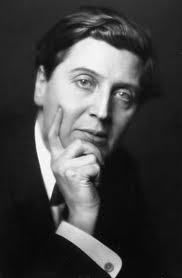
February 4, 2013. Centuries apart: Palestrina and Berg. We missed Giovanni Pierluigi Palestrina’s official birthday by one day: he was probably born on February 3, 1525, but back then church records were not kept very diligently, so we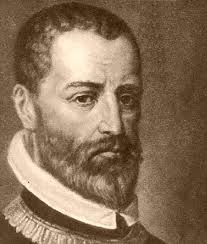 really cannot be sure: other records indicated that he may have been born a year later, on February 2, 1526. One way or another, this is as good a time as any to celebrate this supreme master of Renaissance polyphony. Palestrina’s name refers to the place where he was born, a small ancient town just outside of Rome (the town was a popular summer resort in ancient Roman times and was famous for the magnificent temple of Fortuna). Palestrina went to Rome as a boy and probably started as a chorister at the basilica of Santa Maria Maggiore. He then worked as the organist at several churches and started composing around that time: his first book of Masses was published in1551. It’s interesting to note that till that time, most of the church music performed in Rome was composed by the Franco-Flemish or Spanish composers, such as Guillaume Dufay, Orlando di Lasso, Josquin des Prez and Cristóbal de Morales. Palestrina’s music so impressed Pope Julius III that he made him maestro di cappella of the papal choir at St Peter's, the Cappella Giulia. Later he served as the choirmaster in other famous churches of Rome such as San Giovanni in Laterano and Santa Maria Maggiore, but eventually returned to St-Peters. Palestrina composed a large number of Masses, probably around 100, many madrigals and motets for several voices, from four to twelve. One of his Masses, Missa Papae Marcelli, is famous for saving, it is said, polyphony as art. In the mid-16th century, in reaction to the Reformation, the Catholic Church became concerned with the intelligibility of services, realizing that during Masses parishioners should understand the sacred words, something considered not important in earlier ages. The many-voiced Masses were often unintelligible and the Pope was about to ban them, when, upon hearing Palestrina’s Missa Papae Marcelli, with its beautiful but well-articulated voicing, the Church officials relented and allowed the polyphonic music to continue. The Mass, as its name indicates, was composed in honor of Pope Marcellus II, who reigned for just three weeks in 1555. Here’s Sanctus and Benedictus, performed by The Tallis Scholars, Directed by Peter Phillips.
really cannot be sure: other records indicated that he may have been born a year later, on February 2, 1526. One way or another, this is as good a time as any to celebrate this supreme master of Renaissance polyphony. Palestrina’s name refers to the place where he was born, a small ancient town just outside of Rome (the town was a popular summer resort in ancient Roman times and was famous for the magnificent temple of Fortuna). Palestrina went to Rome as a boy and probably started as a chorister at the basilica of Santa Maria Maggiore. He then worked as the organist at several churches and started composing around that time: his first book of Masses was published in1551. It’s interesting to note that till that time, most of the church music performed in Rome was composed by the Franco-Flemish or Spanish composers, such as Guillaume Dufay, Orlando di Lasso, Josquin des Prez and Cristóbal de Morales. Palestrina’s music so impressed Pope Julius III that he made him maestro di cappella of the papal choir at St Peter's, the Cappella Giulia. Later he served as the choirmaster in other famous churches of Rome such as San Giovanni in Laterano and Santa Maria Maggiore, but eventually returned to St-Peters. Palestrina composed a large number of Masses, probably around 100, many madrigals and motets for several voices, from four to twelve. One of his Masses, Missa Papae Marcelli, is famous for saving, it is said, polyphony as art. In the mid-16th century, in reaction to the Reformation, the Catholic Church became concerned with the intelligibility of services, realizing that during Masses parishioners should understand the sacred words, something considered not important in earlier ages. The many-voiced Masses were often unintelligible and the Pope was about to ban them, when, upon hearing Palestrina’s Missa Papae Marcelli, with its beautiful but well-articulated voicing, the Church officials relented and allowed the polyphonic music to continue. The Mass, as its name indicates, was composed in honor of Pope Marcellus II, who reigned for just three weeks in 1555. Here’s Sanctus and Benedictus, performed by The Tallis Scholars, Directed by Peter Phillips.
Three century after the death of Palestrina, on February 9, 1885 Alban Berg was born in Vienna. One of the three leading composers of the Second Viennese school, he, with Schoenberg and Webern, pretty much transformed our understanding of classical music. Berg started composing when the prevailing trends were those of the late Romanticism. His first piano Sonata, a very formidable opus 1, is written in this style, even though it already contains harmonies that would later develop into the atonal music of his mature period. In 1924 he wrote his first opera, Wozzeck, which became one of the most important compositions of the 20th century. In 1934 - 35 he wrote most of his second opera, Lulu: the first two acts were completed, but Berg managed to finish only parts of the third act. Berg died, impoverished, of blood poisoning at the age of 50, in 1935. One of the reasons he failed to complete Lulu was the break he took from writing the opera to compose a violin sonata. The sonata was a reaction to the death of Manon Groppius, the daughter of his friends Alma Mahler, the former wife of Gustav, and the architect Walter Gropius. Here it is, performed by the violinist Nana Jashvili with the Moscow Philharmonic Orchestra, Jonas Alexas conducting.
PermalinkJanuary 28, 2013. Franz Schubert was born on January 31, 1797. We wrote quite extensively about his life, especially his earlier years (this of course is practically a misnomer, as Schubert died tragically young at the age of 31). During his short life he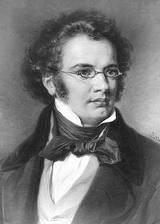 wrote more than 1000 compositions, of which 600 were songs. We think that even if all he wrote were songs, he would still be considered one of the greatest composers ever. His cycles Die schöne Müllerin, written in 1823, and Winterreise, written four years later, contain no less music of the highest order than symphonies of the most gifted composers. Both cycles were originally written for tenor, but are often transposed and performed by other voices. The late Dietrich Fischer-Dieskau, a baritone, was one of the greatest exponents (pianists such as Sviatoslav Richter, Alfred Brendel and Murray Perahia performed Schuber’s songs with Fischer-Dieskau). Gute Nacht is the first of the songs in the Winterreise cycle. Here it is performed by the German bass-baritone Thomas Quasthoff, with Daniel Barenboim on the piano (courtesy of YouTube). Fritz Wunderlich was one of the most brilliant tenors of the 20th century. Unfortunately, like Schubert’s, his life was cut short: he was only 35 when he died in an accident. Still, he left behind a number of exceptional recordings, Die schöne Müllerin being one of them. Here he sings Der Neugierige ("The Inquisitive One"), the sixth song in the cycle. Hubert Giesen is on the piano (courtesy of YouTube). Of course there are many other wonderful songs. Probably one of the most popular is An Die Musik, D. 547. Here it is, in the 1950 recording, sung by the great Elisabeth Schwarzkopf. She is accompanied by Edwin Fischer (also courtesy of YouTube).
wrote more than 1000 compositions, of which 600 were songs. We think that even if all he wrote were songs, he would still be considered one of the greatest composers ever. His cycles Die schöne Müllerin, written in 1823, and Winterreise, written four years later, contain no less music of the highest order than symphonies of the most gifted composers. Both cycles were originally written for tenor, but are often transposed and performed by other voices. The late Dietrich Fischer-Dieskau, a baritone, was one of the greatest exponents (pianists such as Sviatoslav Richter, Alfred Brendel and Murray Perahia performed Schuber’s songs with Fischer-Dieskau). Gute Nacht is the first of the songs in the Winterreise cycle. Here it is performed by the German bass-baritone Thomas Quasthoff, with Daniel Barenboim on the piano (courtesy of YouTube). Fritz Wunderlich was one of the most brilliant tenors of the 20th century. Unfortunately, like Schubert’s, his life was cut short: he was only 35 when he died in an accident. Still, he left behind a number of exceptional recordings, Die schöne Müllerin being one of them. Here he sings Der Neugierige ("The Inquisitive One"), the sixth song in the cycle. Hubert Giesen is on the piano (courtesy of YouTube). Of course there are many other wonderful songs. Probably one of the most popular is An Die Musik, D. 547. Here it is, in the 1950 recording, sung by the great Elisabeth Schwarzkopf. She is accompanied by Edwin Fischer (also courtesy of YouTube).
PermalinkJanuary 27, 2013. Wolfgang Amadeus Mozart was born on this day in 1756, 257 years ago. His genius reigns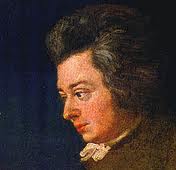 supreme today as it did 200 years ago, and as it will in 200 years. Here’s one reason why: the finale of Le Nozze Di Figaro: Pace Pace mio dolce tesoro (Now peace, my dearest treasure). Figaro: Bryn Terfel, Susanna: Alison Hagley, Count Almaviva: Rodney Gilfry. It’s followed by Gente gente all'armi all'armi (People, to arms!) for the full ensemble. The Monteverdi Choir, John Eliot Gardiner conducting (courtesy of YouTube).
supreme today as it did 200 years ago, and as it will in 200 years. Here’s one reason why: the finale of Le Nozze Di Figaro: Pace Pace mio dolce tesoro (Now peace, my dearest treasure). Figaro: Bryn Terfel, Susanna: Alison Hagley, Count Almaviva: Rodney Gilfry. It’s followed by Gente gente all'armi all'armi (People, to arms!) for the full ensemble. The Monteverdi Choir, John Eliot Gardiner conducting (courtesy of YouTube).
PermalinkJanuary 21, 2013. Approaching Mozart’s birthday. The genius of Mozart, whose birthday we’ll celebrate on the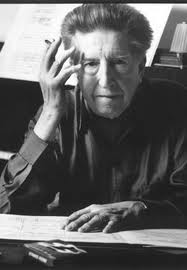 27th, overshadows all other composers born this week, but their contributions are substantial and worth mentioning. Henri Dutilleux will celebrate his 96th birthday tomorrow: he was born on January 22, 1916 in the historic town of Angers on the Loire River. Like so many other French composers, he studied at the Paris conservatory; he won the Grand Prix de Rome in 1938. Even though he started writing music early, Dutilleux wouldn’t number his compositions till the age of 30, as he considered his earlier pieces, including the Prize-winning cantata L'Anneau du Roi, not worth mentioning. Besides composing, he taught at the Ecole Normale de Musique and the Paris Conservatory. While influenced by Debussy and Ravel, Dutilleux’s music is highly original and contemporary. Here’s his String Quartet Ainsi la nuit (So, the night), from 1976. It’s performed by Wonhyee Bae and Tessa Lark, violins, Vicki Powell, viola, and Paul Dwyer, cello.
27th, overshadows all other composers born this week, but their contributions are substantial and worth mentioning. Henri Dutilleux will celebrate his 96th birthday tomorrow: he was born on January 22, 1916 in the historic town of Angers on the Loire River. Like so many other French composers, he studied at the Paris conservatory; he won the Grand Prix de Rome in 1938. Even though he started writing music early, Dutilleux wouldn’t number his compositions till the age of 30, as he considered his earlier pieces, including the Prize-winning cantata L'Anneau du Roi, not worth mentioning. Besides composing, he taught at the Ecole Normale de Musique and the Paris Conservatory. While influenced by Debussy and Ravel, Dutilleux’s music is highly original and contemporary. Here’s his String Quartet Ainsi la nuit (So, the night), from 1976. It’s performed by Wonhyee Bae and Tessa Lark, violins, Vicki Powell, viola, and Paul Dwyer, cello.
These days, Muzio Clementi, born January 24, 1752 and famous in his day, is mostly remembered as the composer of sonatas popular with music teachers, and also for his musical contest with Mozart in Vienna in 1781. Clementi and Mozart were to improvise on the themes suggested by the Emperor Joseph II, and play selections from their own compositions. The Emperor, for whose entertainment the contest was organized, diplomatically declared it a tie. But, though forgotten, Clementi did write some lovely music. Here’s his Sonata in B-flat Major, Op.24 No.2, played by the Korean-American pianist Young-Ah Tak. Note the opening bars of the sonata: they were later used by Mozart in his overture to the Magic Flute!
Also, Witold Lutoslawski, one of the greatest Polish (and European) composers of the 20th century, was born this week, on January 25, 1913. He stared studying violin, but later switched to piano and composition at the Warsaw conservatory. For a while he was also taking classes in mathematics at the University of Warsaw. Lutosławski was in the military when the Germans attacked Poland in September of 1939. He was captured but managed to escape. He made it to Warsaw and earned money by playing piano duets with his friend, the composer Andrzej Panufnik. After the Soviets liberated Poland and then installed a communist regime, life became increasingly difficult for Lutosławski.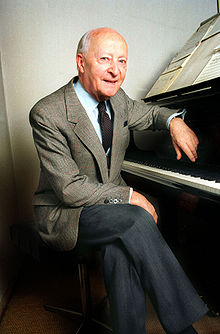 He was accused of “formalism” and his compositions were censored. These problems continued even after Stalin’s death, but eased somewhat after Lutosławski achieved international fame (Pierre Boulez premiered his Second symphony in 1966). Lutosławski, who always opposed communist rule, was a big supporter of the Solidarity movement in the early ‘80s. He was very prolific till the very end of his life. Lutosławski wrote four symphonies and a number of other symphonic compositions - concertos for piano, violin, cello (written and premiered by Mstislav Rostropovich) and many chamber and vocal pieces. Here’s Capriccio notturno ed Arioso from his Concerto for Orchestra (1950-1954). It’s performed by The Texas Festival Orchestra, Edwin Outwater conductor. The piece is written in Lutosławski’s earlier, “folkloristic” style, far removed from the atonal and even aleatoric music of his later compositions.
He was accused of “formalism” and his compositions were censored. These problems continued even after Stalin’s death, but eased somewhat after Lutosławski achieved international fame (Pierre Boulez premiered his Second symphony in 1966). Lutosławski, who always opposed communist rule, was a big supporter of the Solidarity movement in the early ‘80s. He was very prolific till the very end of his life. Lutosławski wrote four symphonies and a number of other symphonic compositions - concertos for piano, violin, cello (written and premiered by Mstislav Rostropovich) and many chamber and vocal pieces. Here’s Capriccio notturno ed Arioso from his Concerto for Orchestra (1950-1954). It’s performed by The Texas Festival Orchestra, Edwin Outwater conductor. The piece is written in Lutosławski’s earlier, “folkloristic” style, far removed from the atonal and even aleatoric music of his later compositions.
Permalink